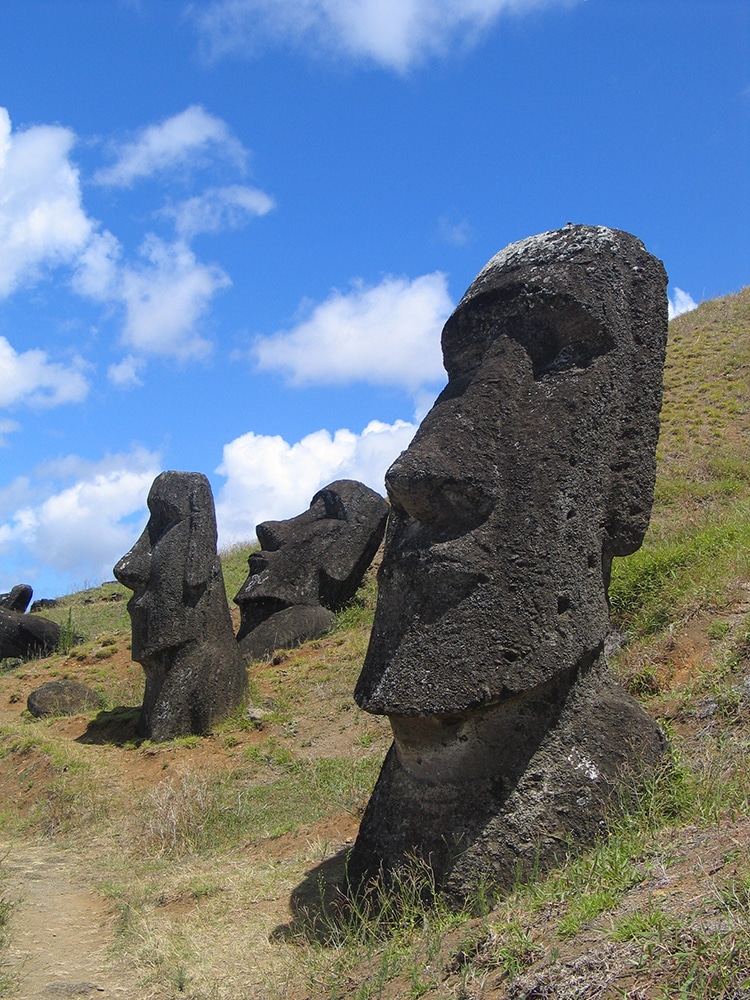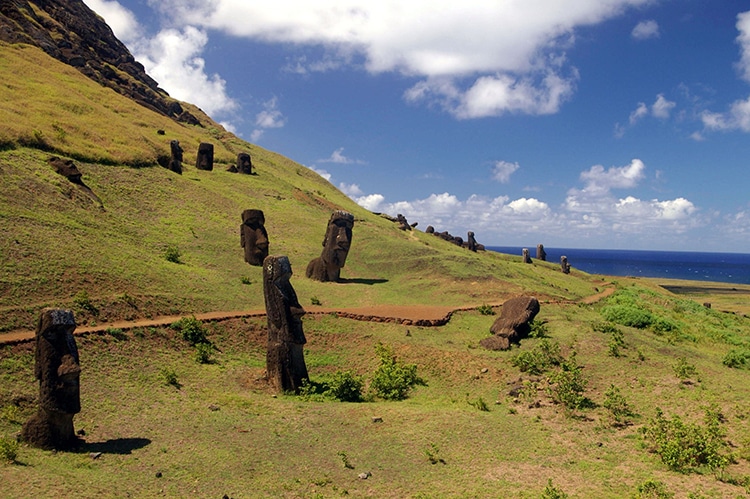
Moai at Rano Raraku, Easter Island. (Photo: Wikimedia Commons, Public domain)
Easter Island is known for its giant stone statues with stoic faces, known as moai. The small volcanic landmass in the Pacific Ocean is home to the indigenous Rapa Nui people, whose ancestors impressively crafted the moai. Ranging in size from three to 80 tons and towering up to 33 feet tall, the island’s roughly 1,000 moai have long been an object of fascination around the world. Yet the story of the moai is still evolving: a new statue was discovered at the bottom of a dry lake bed. Exposed by climate change’s effects, the new moai offers insight into what other hidden history the island may reveal.
The moai was discovered in a dried-up lake situated in a quarry on the island. It was long obscured by reeds, but receding water levels due to climate change exposed a glimpse of the stone. The find was announced by Salvador Atan Hito, the vice president of Ma’u Henua, the Indigenous organization that oversees the national park which stretches across much of the island. “For the Rapa Nui people, it’s [a] very, very important discovery,” Hito told Good Morning America. “Because it’s here in the lake and nobody knows this exists—even the ancestors, our grandparents don’t know [about] that one.”
The find suggests more moai may be yet to be discovered. “The moai are important because they really represent the history of the Rapa Nui people,” Terry Hunt, professor of archeology at the University of Arizona, said. “They were the islanders’ deified ancestors. They’re iconic worldwide, and they really represent the fantastic archeological heritage of this island… We think we know all the moai, but then a new one turns up, a new discovery, and in this case, in the lake, at the statue quarry. There have been no moai found in the dry bed or in what was previously a lake, so this is a first.”
The Easter Island moai were carved between 1250 and 1500 CE. Some have been discovered to have buried stone “bodies.” Made of soft volcanic tuff, their faces gazed inland watching over their people. The moai were commissioned by individuals or groups and carved by teams working under master carvers. Transported on sleds, or with ropes and levers, the finished carvings eventually made their way to their posts watching over the island. European arrivals in the 18th century noted the moai, but by mid-19th century the statues had fallen. Restorations have restored many to their upright position. Future searches for new moai will also look for tools and writings to learn more about the “heads” and their fascinating history.
A new moai statue has been discovered at the bottom of a dry lake bed on Easter Island, a land famous for its stony-faced statues.

The outer slope of the Rano Raraku volcano, the quarry with many uncompleted statues. (Photo: Rivi Wikimedia Commons, CC BY-SA 3.0)
Related Articles:
Dual Mayan Stele Featuring a Female Deity Is Unearthed in Southeastern Mexico
Medieval Human-Shaped Lead Sarcophagus and More Found Under Notre-Dame Cathedral
Researchers Discover 1,000-Year-Old Burial of a Highly Elite Nonbinary Individual
Explore the Fascinating History of Petra, a Once-Lost City That’s Now a Wonder of the World
